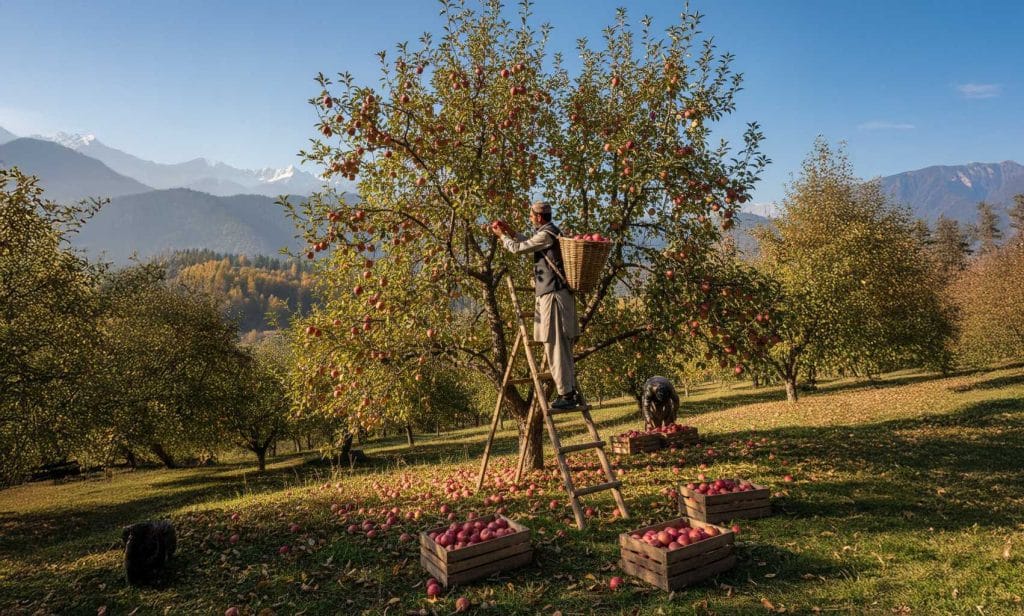Introduction:
Harvesting is a critical phase in the fruit cultivation process, and its proper execution significantly influences the storability and overall quality of the fruit, ultimately determining the success of the orchardist’s efforts. The decisions made during harvesting can impact the fruit’s condition for months, especially considering the time it takes for the produce to reach the market. Therefore, orchardists must follow a strategic approach that includes informed decisions on when to harvest, how to harvest, and the implementation of post-harvest management strategies to maximize returns. Apples are considered climacteric fruits, meaning they continue to undergo metabolic processes after harvesting. If we don’t handle them correctly throughout their journey from the farmer to the consumer, the fruit will keep ripening and get worse. The following tips can assist in preserving the quality of the fruit.
Time of Harvest: Harvesting should be done when apples attain their optimum maturity stage and it varies from variety to variety. The time of harvest can be predicted from a number of ways like days from full bloom to harvest, change in colour, size and taste. Various tests and instruments can also be used to ascertain the maturity like starch index test, handheld refractometer etc.
How to Harvest: When harvesting, twist the apple slightly while lifting it upward. Avoid pulling straight away from the tree, as this can damage the branch and the bud for next year’s fruit. Handle apples gently to avoid bruising. Place waste bins strategically in the orchard for the disposal of damaged or rotting fruit. Overfilling bins should be avoided as well. Make sure these bins are easily accessible for collection. This approach helps prevent disease and pests from building up in the orchard and safeguards next year’s crop. During harvest, the fruit’s temperature is often a few degrees higher than the surrounding air temperature. To mitigate this, it is best to pick the fruit in the early morning once the dew has evaporated. Cooling the fruit should begin right in the field because removing the field heat is the most critical step in prolonging the fruit’s shelf life and preserving its quality.
On Farm Care: Exposing apples to direct heat in an open environment should be avoided, as it could lead to potential sun damage. Apples are especially susceptible to damage during transportation from the field to the packing shed. Therefore, it is essential to ensure that the on-farm roads are smooth to prevent unnecessary jolts or vibrations that could harm the filled bins during transport.
How to store: It is essential to protect freshly picked fruit from direct sunlight because exposure to sunlight can raise the fruit’s respiration and ethylene production rates, leading to a shorter shelf life. To maintain the fruit’s quality, it is important to gather the bins from the orchard promptly and keep them shaded during transportation to the packing shed. The time between picking and storing apples is crucial to minimize the impact of temperature on the fruit. Continuously transfer produce from the field to the packing shed for pre-conditioning and cooling. Cover the fruit for transportation to the packing shed using available bin covers to protect it from the sun and dust.
Post-harvest treatment: Post-harvest sprays in apples are typically applied to protect the fruit from various pests and diseases during storage and transportation. Look for pesticides with lower PHI (pre harvest interval) values. This will allow for a shorter time between the last application and harvest, reducing the risk of residues on the harvested fruit, also select pesticides that have lower MRLs (Maximum Residue Limit) established for apples, and make sure to follow the recommended application rates to stay within acceptable residue levels.
Precautions:
1. Make regular trips between the field and packing shed, where cool rooms are located.
2. Cover bins in the field and during their removal and transportation to the packing shed.
3. Take measures to minimize bruising during the packaging process.
4. Remove field heat from apples before placing them into storage.
5. Avoid exposing produce to direct sunlight; store it in the shade and cover it during transportation to the packing shed.
6. Handle bins of fruit with care, avoiding aggressive handling or overfilling.
7. Promptly collect filled bins from the orchard and ensure they are shaded during transport back to the packing shed.
8. Maintain cleanliness in transport equipment, containers, the packing shed, and storage rooms.
Conclusion:
Successful apple production does not end at the orchard but extends into careful handling, storage, and post-harvest management. By harvesting at the right maturity stage, using proper picking techniques, and minimizing damage during handling and transport, orchardists can significantly extend the fruit’s shelf life and preserve its quality. Timely cooling, shading, and protection from sun and physical stress are equally important to maintain freshness until the fruit reaches consumers.


